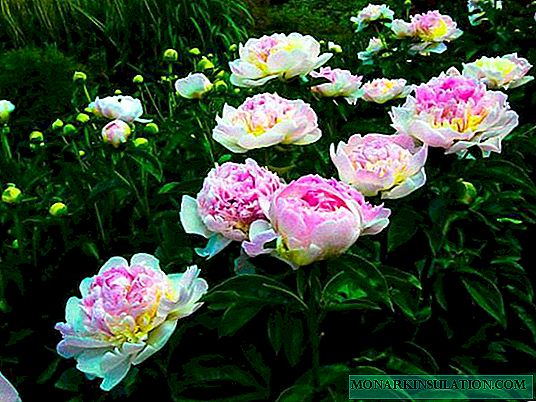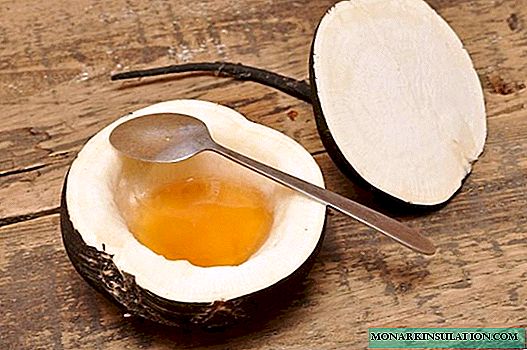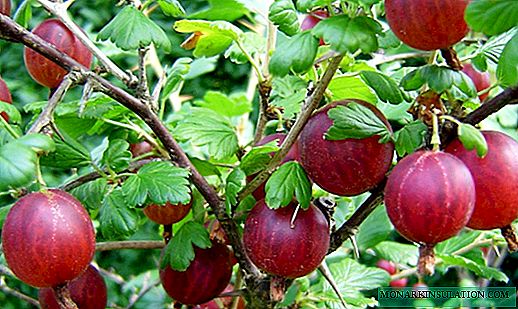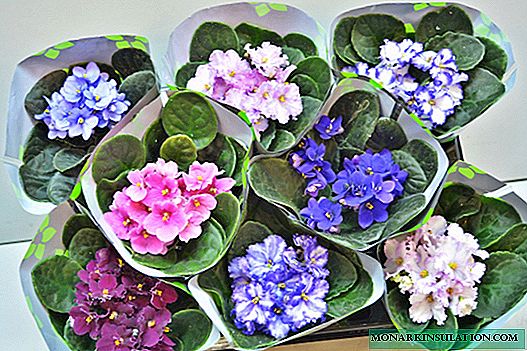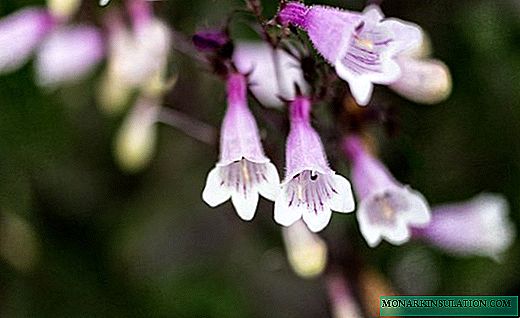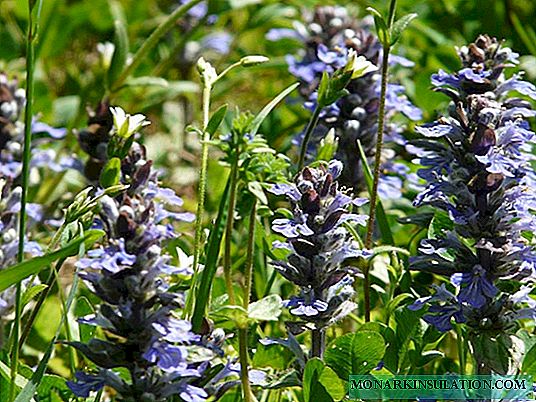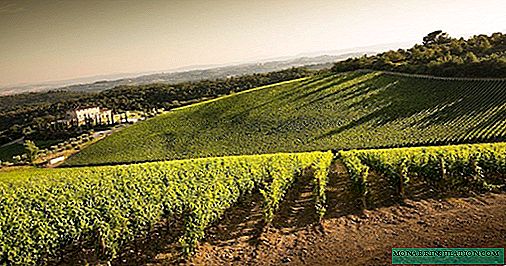
Scientists have found that grapes are unpretentious in the choice of soil, any suitable for it, except salt marshes and swamps. For his own growth, he does not particularly need fertile land, he feels great both on rocky and sandy soil. But if we want to grow a vine that gives a high yield, we will have to feed it the entire growing season.
Menu for grapes
Grapes - a woody perennial vine of the grape family. Shoots of grapes - vines - can reach a length of several meters. They are excellent climbers: clutching their tenacious antennae on branches, partitions, ledges, they easily climb onto tree crowns, roofs of arbors, arches and other buildings. Fruits - juicy berries of pleasant sweet and sour taste - are collected in a tasty bunch.
The history of the origin of grapes is rooted in the past for many millennia, and it does not matter who and when was the first to discover this wonderful creation of nature, it is important that it has come down to us, has been multiplied by beautiful varieties and pleases with the splendor of choice and taste.

Bunches of grapes, cherished by the sun and caring hands, delight with great taste
"There is no greater enjoyment in the world than to feel the fragrance of a flowering vineyard ..."
Pliny the ElderCollection of quotes
Top dressing of grapes begins "from the cradle". The planting pit is seasoned with soil mixtures, well-fertilized organics and minerals so that the young bush has enough nutrition for the next year or two. Contributed by:
- 1-2 buckets of humus or rotted manure;
- 200 g of superphosphate and 150 g of potassium sulfate (or 1 liter of ash).
Then you can start root and foliar top dressing. For proper nutrition of grape bushes, inorganic and organic fertilizers are used.
Mineral fertilizers
Inorganic, or mineral, fertilizers are:
- simple, consisting of one element (phosphorus, nitrogen, potassium);
- complex, consisting of 2-3 elements (for example, azofoska, potassium nitrate, ammophos);
- complex, including a concentrated complex of minerals and microelements (for example, Biopon, Clean sheet, AVA, Zdorov, Super Master, Novofert, Plantafol). Advantages of complex fertilizers:
- balanced in composition and concentration of elements;
- contain all the necessary components for a particular plant;
- simplify the task of the winegrower in the calculations during application.
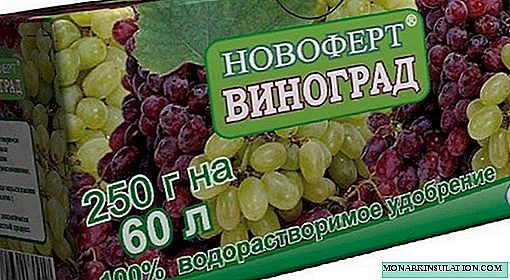
Fertilizer Novofert "Grapes" is recommended to be used after completion of flowering vines
Some of the mineral fertilizers are especially important for grapes.
Potassium
No matter how tasty we “fed” our grapes, if potassium is not on the menu, the vine will require it, because potassium:
- helps the rapid growth of shoots;
- accelerates the ripening process of berries;
- increases their sugar content;
- contributes to the timely maturation of the vine;
- helps the grape bush to survive wintering, and in the summer to withstand the heat.

On soils with a sufficient supply of moisture, potassium salt under the vine can be applied in early spring
Azofoska
Azofoska is a complex fertilizer that includes the elements of primary importance in the proportions the plant needs, the grapes needed to get a good harvest and support for the bush:
- nitrogen,
- potassium,
- phosphorus.
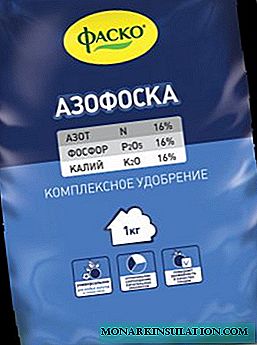
Azofoska is used for pre-sowing and planting under the vine
Fertilizer is used in two ways:
- direct introduction of dry matter into the ground;
- pouring the solution to the roots through drainage pipes or trenches.
Urea
Urea (urea) is one of the main nitrogen fertilizers necessary for grapes, it contributes to:
- rapid vine growth;
- building green mass;
- enlargement of a bunch.

Timely application of urea (at the beginning of the growing season) contributes to the rapid growth of the vine
Boron
A lack of boron has a negative effect on the formation of grape pollen, which impairs the fertilization of the ovaries. Even simple foliar top dressing of grapes with boron before flowering can increase the yield by 20-25%. Boron and boron-containing substances:
- help the synthesis of nitrogen compounds;
- increase the content of chlorophyll in the leaf;
- improve metabolic processes.
Important! An excess of boron is even more harmful than a deficiency, which means that when preparing the solution it is necessary to carefully calculate the dose according to the instructions.

A lack of boron leads to a deterioration in the formation of ovaries of grapes
Organic fertilizer
During the entire growing season, in addition to inorganic fertilizers, it is possible and necessary to feed grapes with organic. Inorganic and organic fertilizers have their fans and opponents, therefore, dear reader, it is up to you and you to decide what to give preference to. Or maybe find a middle ground - use organic as a “snack” between the main dressings? Moreover, our choice is wide.
Manure
This is a livestock product that contains a lot of useful substances:
- nitrogen,
- potassium,
- phosphorus,
- calcium.
Horse manure is considered the best, then there is cow, or mullein. Before using this organic fertilizer, you need to give it re-use (goes to fertilize the earth around the bush) or prepare an infusion (for watering around the roots) this way:
- In a container, the volume of which depends on how much infusion is needed, put fresh manure and add water in a 1: 3 ratio.
- Close tight.
- Insist for two weeks, periodically mixing well. It will be a mother liquor.
- To prepare a working solution, 1 liter of the mother liquor must be diluted in 10 liters of water.
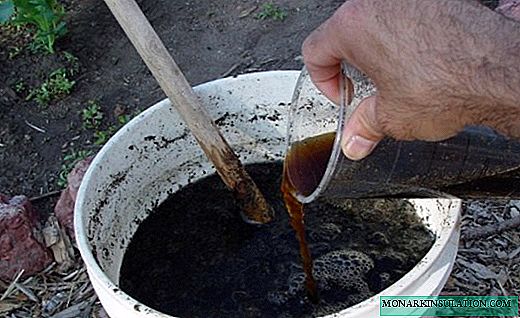
To prepare a working solution of mullein, 1 l of the mother liquor is diluted in 10 l of water
Grapes are fed with mullein infusion through drainage pipes or trenches once every two weeks, combining with watering.
Bird droppings
Bird droppings are a product of the life of birds, an equally valuable organic fertilizer. It can be laid in compost or used as an infusion. The order of preparation of the infusion:
- Pour a kilogram of dry bird droppings into a bucket.
- Then add 10 liters of water.
- Leave to ferment, stirring occasionally. After 2 weeks, the mother liquor is ready.
- To prepare the working solution, dilute the mother liquor in a ratio of 1:10 in water.

Bird droppings sold in garden stores
Poultry manure infusion is poured through drainage pipes or in trenches between the main dressings, combining with watering once every two weeks.
For top dressing with tinctures of manure and bird droppings, we select one thing or alternate so as not to overfeed the plant.
Wood ash
Wood ash is an ideal top dressing for grapes, it includes:
- approximately 10% magnesium and phosphorus;
- about 20% potassium;
- up to 40% calcium;
- sodium, magnesium, silicon.
When dry, it significantly improves both the mechanical and chemical composition of the soil, alkalizing it. On heavy soils, ash is brought in for digging in autumn and spring, and on light sandy loam - only in spring. The application rate is 100-200 g per 1 sq. Km. m
It should be noted that ash is not used at the same time as nitrogen fertilizers, since it contributes to the "volatilization" of nitrogen, so we will use foliar feeding with ash infusion for grapes. It is done like this:
- Wood ash is poured with water in a ratio of 1: 2.
- Insist for several days, stirring regularly.
- Then it is filtered and 2 liters of water are added to each liter of uterine infusion.
Ash infusion is sprayed with plants between the main dressings.

For grapes, foliar top dressing with ash infusion is used.
Eggshell
Egg shells also belong to organic fertilizers. It almost entirely (94%) consists of calcium carbonate. Fertilizer from it is prepared as follows:
- After using the eggs, the shell is collected, washed and dried.
- Dry and clean shells are ground in a grinder (if a small amount, then it is possible in a coffee grinder).
- Ready fertilizer is laid in any convenient container.
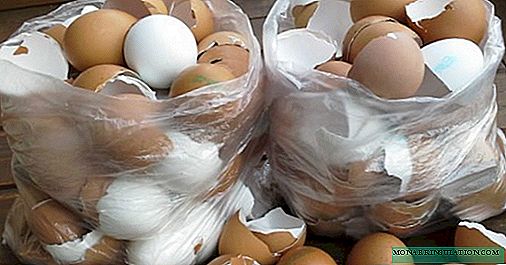
Rinse and dry the eggshell before chopping
Use crushed eggshells to deoxidize the soil around the grapes as necessary, at the rate of 0.5 kg of powder per 1 sq. m
Herbal infusion
A wonderful organic fertilizer is herbal infusion. To prepare it, you need a large capacity. Make an infusion in this way:
- Fill the container (usually a barrel) with one third of fresh grass.
- Top up with water, not reaching the top 10-15 cm.
- Then cover with a loose cloth or gauze and insist 3-5 days, periodically mixing the contents.
- Ready infusion is filtered.

The best herbal infusion is obtained from nettles
The rest of the grass is placed in a compost heap, after rotting it will turn out grass compost, and the infusion is used for root and foliar dressing at the rate of 1 liter of infusion per 10 liters of water. Root top dressing is combined with watering, foliar is carried out between the main sprayings on the sheet.
Yeast infusion
A good addition to the menu is grape yeast infusion. This fertilizer is completely safe for humans and plants. Yeast contains:
- saccharomycetes fungi,
- B vitamins,
- squirrels
- carbohydrates
- trace elements.
To prepare the yeast infusion you need:
- Pour breadcrumbs into the bucket - about a fourth of the volume.
- Add 2-3 tablespoons of sugar and 50 g of raw baking yeast.
- Pour in water, leaving room for fermentation.
- Insist in a warm place until you get bread kvass.
The working solution is made at the rate of 1 liter of infusion per 10 water. Top dressing they combine with watering.
Video: do-it-yourself organic fertilizer for grapes
Topping grapes by time
During the growing season, 7 top dressing of grapes is carried out, of which two are foliar. Doses and terms of fertilizer application are indicated in the table below.
Spring root dressing
As soon as the buds begin to swell on the vine, spring root dressing is carried out with a complex of mineral fertilizers, which includes:
- ammonium nitrate or urea,
- superphosphate,
- potassium salt.
Fertilizer is necessary for grapes to replenish the supply of nutrients after a period of rest. All solutions of mineral fertilizers are made in accordance with the attached instructions. Spend feeding in this way:
- The prepared fertilizer is poured through drainage pipes or, if none are available, into small pits or trenches dug at a distance of 50 cm from the bush, 40-50 cm deep.

In pits 60 cm deep, pipes with a diameter of 10-15 cm are laid on a gravel pillow through which underground grape watering is carried out
- After that, they cover the trenches or fill them with mowed grass.
Top dressing before flowering
The second time we feed the grapes in the third decade of May before the beginning of flowering under the root, using the same composition as for the first feeding, but with a lower dosage of fertilizers and according to the leaf. This will improve pollination, will contribute to the enlargement of the bunch.
Top dressing to improve berry ripening
The third time we apply fertilizer under the root, consisting of superphosphate and potassium salt, before the berries ripen, which will increase their sugar content and accelerate ripening. We do not add nitrogen to this top dressing so that the vine has time to ripen and lignite well. For small berries we carry out foliar spraying with a complex mineral fertilizer.

Superphosphate is used during the ripening period of grapes
Fertilizer after harvest
After harvesting, the bushes must be fed with potassium sulfate and superphosphate to replenish the supply of nutrients and increase the winter hardiness of the plant. In addition, once every 3 years in late autumn, humus or compost based on bird droppings, manure, plant residues is brought into the hole for digging (at the rate of 1-2 buckets per square meter). This improves the chemical and mechanical composition of the soil.

Once every 3 years, in late autumn, 1-2 buckets of humus are brought into the hole for digging
Foliar top dressing
In addition to root dressing, we carry out two foliar, one 2-3 days before flowering, the other according to small ovaries. Foliar top dressing is carried out in dry, calm weather at sunset, so that the solution stays wet longer on the sheet. You can process plants during the day if it is cloudy.
Not all winegrowers consider foliar top dressing very effective, but they are not in a hurry to refuse them, using as an additional feed in tank mixtures when processing the vineyard from various diseases.
What gives foliar top dressing? I believe that when spraying a plant, nutrients are absorbed by the leaf in a few minutes, which means that grapes will receive nutrition several times faster. This method is good in case of emergency assistance to a weakened bush.
Table: feeding scheme and approximate amount of fertilizer per 1 grape bush
| Top dressing | When is | Fertilizer | goal | Mode of application |
| 1st root | With swelling of the kidneys |
| Nutritional Replenishment substances after a period of rest | It is embedded in the ground around the bush or dissolved in 10 liters of water and poured through drainage pipes |
| 2nd root | A week before flowering |
| Supports Intensive Growth shoots, reduces shedding ovary, nourishes the bush | It is embedded in the ground around the bush or dissolved in 10 liters of water and poured through drainage pipes |
| 1st foliar | 2-3 days before flowering | Usually combined with spraying bushes fungicides. For 10 liters of water:
| Improves pollination, reduces shedding of the ovary, contributes enlarge brush | Sprayed by by sheet in the evening |
| 2nd foliar | After flowering by small peas |
| Prevents grape chlorosis and crest paralysis | Sprayed by by sheet in the evening |
| 3rd root | 1-2 weeks before ripening |
| Prevents cracking berries, improves their taste quality, speeds up a little maturation | It is dissolved in 10 l of water and poured through drainage pipes |
| 4th root | After harvest |
| Improves shoot maturation | It is dissolved in 10 l of water and poured through drainage pipes |
| Autumn | Once every 2-3 years | 1-2 buckets of humus per 1 square. m | Nourishes the soil around the bush improves its chemical and mechanical composition | It is brought under digging |
Video: how and what to fertilize grapes properly
Fertilizing grapes is an important element in the development of the bush and the key to good fruiting. Follow the processing time, fertilize correctly, and the vine will thank you with a generous harvest.










